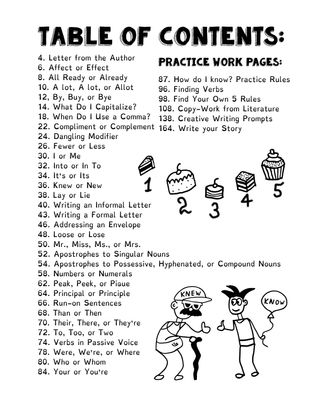Top 30 Grammar Mistakes: A Do-It-Yourself Homeschooling Handbook (11+)
Master the Top 30 Grammar Mistakes!
Learn fun and interesting ways to learn and remember the 30 grammar rules that are misused the most. Once you learn them you can create your own clever ways to learn grammar rules.
Sometimes making an illustration, writing silly sentences, or a story will help you remember the rule or which word to use. Do you know when to use LOOSE or LOSE, AFFECT or EFFECT? Do you when to add an apostrophe to a singular noun? Learning them won't be boring when using the Thinking Tree's Top 30 Grammar Mistakes.
Here is a list of common grammar mistakes that this book will help you to understand:
Affect or Effect
All Ready or Already
A Lot, Alot, or Allot
By, Buy, Bye
What do I Capitalize?
When Do I Use A Comma?
Compliment or Complement
Dangling Modifier
Fewer or Less
I or Me
Into or In To
It's or Its
Knew or New
Lay or Lie
Writing An Informal Letter
Writing A Formal Letter
Addressing An Envelope
Loose or Lose
Mr. Miss. Mrs. Ms.
Apostrophes to Singular Nouns
Apostrophes to Possessive, Hyphenated, or Compound Nouns
Number or Numerals
Peek, Peak, Pique
Principle or Principal
Run-on Sentences
Than or Then
There, Their, or They're
To, Too, Two
Verbs in Passive Voice
Were, We're, Where
Who or Whom
You're or Your
This activity book is perfect for all ages! Overcome your grammar mistakes and become a more confident writer!
Also included are copywork pages so you don't have to have a separate binder for it. It's all in one place.
By The Makers of Dyslexia Games Therapy & Thinking Tree Books!
By Linda Beltran, Tolik Trishkin & Sarah Janisse Brown
Watch this video to learn more and see inside.
You may also enjoy Are You a Math Genius? The Inventor's Book of Calculation Games and Core Journal - Writer's Fun-Schooling Journal.
Thinking Tree Learning Levels:
A1 = Pre Reader (Pre-K) ages 2-5
A2 = Beginning Readers (K-1st) ages 6-7
B1 = Early Elementary (2nd-3rd) ages 8-9
B2 = Upper Elementary (4th-6th) ages 10-11
C1 = Junior High (7th-8th) ages 12-14
C2 = High school + (9th-adult) ages 13+
Many Thinking Tree Journals span a wide variety of ages because the students use books at his/her reading level. For example, some journals may say for ages 7-17 because you customize it and meet the student where he’s at.
Reproducible for Family Use Only.
_edited.png)











